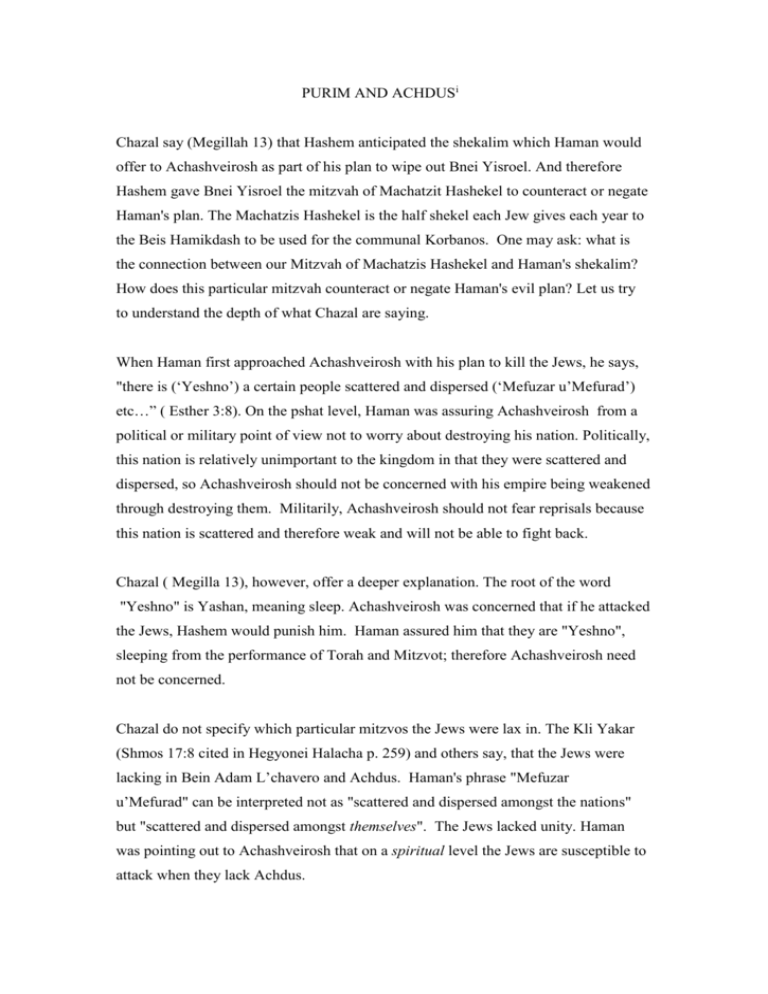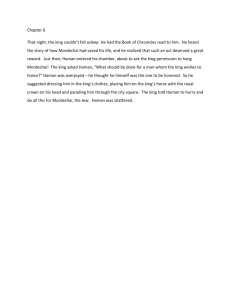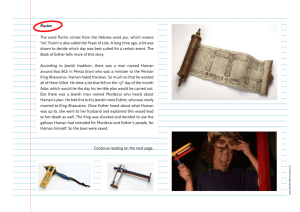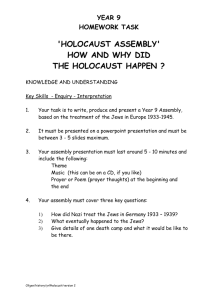A Word From Our Wise
advertisement

PURIM AND ACHDUSi Chazal say (Megillah 13) that Hashem anticipated the shekalim which Haman would offer to Achashveirosh as part of his plan to wipe out Bnei Yisroel. And therefore Hashem gave Bnei Yisroel the mitzvah of Machatzit Hashekel to counteract or negate Haman's plan. The Machatzis Hashekel is the half shekel each Jew gives each year to the Beis Hamikdash to be used for the communal Korbanos. One may ask: what is the connection between our Mitzvah of Machatzis Hashekel and Haman's shekalim? How does this particular mitzvah counteract or negate Haman's evil plan? Let us try to understand the depth of what Chazal are saying. When Haman first approached Achashveirosh with his plan to kill the Jews, he says, "there is (‘Yeshno’) a certain people scattered and dispersed (‘Mefuzar u’Mefurad’) etc…” ( Esther 3:8). On the pshat level, Haman was assuring Achashveirosh from a political or military point of view not to worry about destroying his nation. Politically, this nation is relatively unimportant to the kingdom in that they were scattered and dispersed, so Achashveirosh should not be concerned with his empire being weakened through destroying them. Militarily, Achashveirosh should not fear reprisals because this nation is scattered and therefore weak and will not be able to fight back. Chazal ( Megilla 13), however, offer a deeper explanation. The root of the word "Yeshno" is Yashan, meaning sleep. Achashveirosh was concerned that if he attacked the Jews, Hashem would punish him. Haman assured him that they are "Yeshno", sleeping from the performance of Torah and Mitzvot; therefore Achashveirosh need not be concerned. Chazal do not specify which particular mitzvos the Jews were lax in. The Kli Yakar (Shmos 17:8 cited in Hegyonei Halacha p. 259) and others say, that the Jews were lacking in Bein Adam L’chavero and Achdus. Haman's phrase "Mefuzar u’Mefurad" can be interpreted not as "scattered and dispersed amongst the nations" but "scattered and dispersed amongst themselves". The Jews lacked unity. Haman was pointing out to Achashveirosh that on a spiritual level the Jews are susceptible to attack when they lack Achdus. If Am Yisroel is weakened by a lack of Achdus, then it follows, that to defend and strengthen ourselves, we must improve our Bein Adam L’chavro and Achdus. The Manos Halevi, an important commentary on the Megilla written by Rav Shlomo Alkabetz zt”l (the author of Lecha Dodi), explains three points in the Megillah based on this theme. First, when Esther begins her attempt to save the Jews, she directs Mordechai to "go and assemble the Jews etc..." (Esther 4:6). The Manos Halevi (p.140) and others explain that Esther was trying to counteract Haman's claim. She wanted the Jews to specifically express Achdus through gathering together to fast. The Jews are no longer scattered and dispersed amongst themselves. (This connection between Esther's directive and Haman's claim is first alluded to in the Midrash Tehillim 22:7). Second, the Manos Halevi (p.206, 208) interprets the Mitzvah of Mishloach Manos based on this theme as well. Mordechai and Esther instituted this Mitzvah that each person "sends delicacies to his friend" to emphasize the Achdus and friendship. We must negate Haman's claim. Finally, the Megilla writes "V'kiblu Hayehudim" (and the Jews accepted etc…) (Esther 9:28). The Hebrew word used is pronounced V'kiblu- meaning 'and they accepted'. But it is spelled "V'kebel" the singular form, without the 'vav'. Why? The Manos Halevi (p. 207) explains that the spelling is meant to reflect the Achdus the Jews felt at that time. They accepted Mordechai's directive as a single unit (similar to Shmos 19:2 with Rashi there). We find in Hilchos Megilla a special requirement to read the Megilla in front of ten people. One can even find cases where if a minyan is not present, no Bracha is recited before the reading of the Megilla (M.B. 690:61). The Sfas Emes (Shmos p.188) explains that since the main salvation of Am Yisroel came through gathering together to show Achdus, Chazal instituted this special requirement of reading B'tzibur.ii The Ohr Gedalyahu (Moadim p.85)iii explains that the basic lesson of Machatzis Hashekel is achdus. Every Jew must realize that he only represents half of a whole. Each Jew needs to join with the rest of Bnei Yisroel in order to make a full contribution to the Beis Hamikdash. Our service to Hashem must be as a national unit, with each individual member playing his role as part of the larger whole. By myself, I'm only "half". This is the message of Machatzis Hashekel. Based on the above, I think one can explain the Gemara with which we started. The Mitzvah of Machatzis Hashekel teaches Achdus. Amalek attacks Bnei Yisroel when we lack achdus, as Haman himself said. Therefore Hashem gave us Machatzis Hashekel to negate Haman's claim which accompanied his giving of Shekalim to Achashveirosh. We always read Parshas Shekalim before Purim. Part of our preparation for the struggle against Amalek is working on the Achdus in Am Yisroel. This is part of our Avodah for Purim. If we learn the lesson of Machatzis Hashekel and work on Bein Adam L'chavero to achieve Achdus, we will be impervious to any attack from Amalek. Purim Sameach, B. Ginsburg i Based on the Ohr Gedalyahu The theme we have developed is that Am Yisroel is susceptible to attack by Amalek when we lack Achdus, and we must strengthen our Achdus to defend ourselves. The Kli Yakar explains Amalek's first attack against the Jews in Parshas B'shalach based on this theme as well. The Posuk which immediately precedes Amalek's attack in the Torah refers to the place of Masa U'Meriva, "complaining and testing" (Shmos 17:7). On a simple pshat level, "complaining and testing" refers to the Jews' complaints against Hashem concerning lack of water. The Kli Yakar points out, however, (based on Rashi [Shmos 19:2]) that this refers as well to the Jews complaining and arguing amongst themselves. The Jews lacked Achdus in all their encampments in the Midbar until they reached Har Sinai. So again we find that Amalek attacks when Am Yisroel lacks Achdus. ii The Kli Yakar points out further that the Hebrew letters of Rephidim, the place where Amalek attacked, are the same as the word 'Preidim' (just switch the 'peh' and the 'resh'). 'Preidim' means separated. Am Yisroel were separated amongst themselves, and that is what allowed Amalek to attack. When Bnei Yisroel fought back against Amalek in Parshas B'shalach, the Torah records that Aharon and Chur supported Moshe's arms. What is the significance of Aharon and Chur in this context? The Kli Yakar explains that Chur was Miriam's son. Miriam is the ultimate symbol of Mitzvos Bein Adam L’chavero and Gemilus Chasadim. She was a midwife who constantly helped others give birth and later helped Moshe Rabeinu by the Nile river. Aharon of course is "Ohev Shalom V'rodef Shalom" (Avos 1:12); he constantly tried to bring Achdus and harmony amongst Bnei Yisroel. It is quite fitting that these two support Moshe's arms. We must emphasize Mitzvos Bein Adam L'chavero and Achdus in our struggle against Amalek (the Kli Yakar himself explains Aharon's role somewhat differently). The Torah presents one more attack by Amalek against Bnei Yisroel (Bamidbar 21:1, see Rashi there). Rashi there quotes Chazal that Amalek attacked upon hearing that Aharon died. One can explain that when Aharon, the Ohev Shalom V'rodef Shalom died, the Jews' Achdus was weakened and therefore became susceptible to attack by Amalek. iii An earlier makor for this idea is the Alshich on Parshas Ki Tisa quoting Rav Shlomo Alkabetz zt”l.










